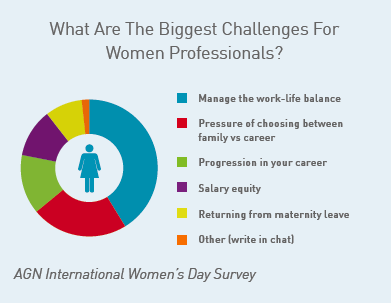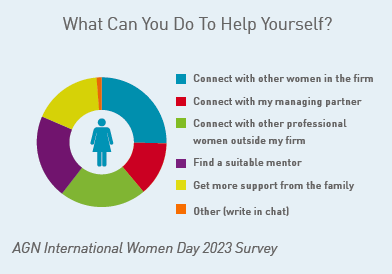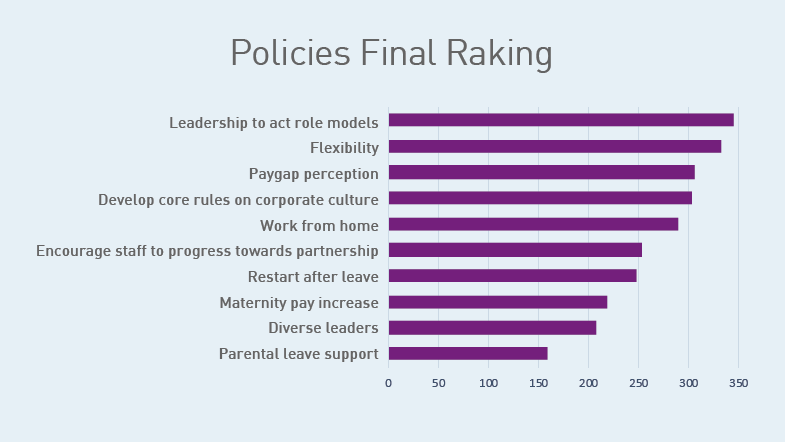AGN Global Business Voice: Practice Management
A firm’s Diversity and Inclusion (D&I) strategy tackles gender and ethnic equity. It also addresses issues related to sexual orientation, socioeconomic status, age, religious beliefs, and physical or mental disabilities.
There is evidence that a workforce characterized by diversity fosters creativity and innovation. We also know that organizations that fail to embrace diversity and inclusivity in their workplaces tend to experience higher turnover rates, as they face an increased risk of nurturing a hostile work environment.
According to a recent McKinsey report, companies that ranked lowest in terms of diversity were nearly 30% more likely to underperform in terms of profitability.
It’s in this context that we alight upon the issue of gender diversity as a focus for this GBV, providing a practical guide to getting the basics right and creating the best environment for enhanced staff retention and improved productivity.
Diversity and inclusion (D&I)
Diversity and inclusion (D&I) is not a new issue, but its importance has increased further as global talent shortage and mobility has been precipitated post-pandemic. AGN has been working with its members to devise valuable approaches and solutions. Some of the key issues were included in our publication – Good business, or a matter of survival? (2021). It highlighted why and how a professional and well-designed diversity policy could provide access to a larger pool of potential professional talent.
“CPA firms have much to lose if women in management continue to leave the profession and change is not implemented to increase retention. To implement positive change, one must be aware that an issue exists and understand the long-term consequences to an organization if change is not made.”
Angelina Milo, CPA, Meaden & Moore, US.
Throughout the profession, female accountants can be both underrepresented and face considerable challenges in the pursuit of their careers – facts not lost on our own members and their female staff.
The AGN ‘Women of Impact’ (WOI)
The AGN ‘Women of Impact’ (WOI) program has been gaining momentum since its inception with the WOI Awards in 2021. This was followed by 2022’s WOI Global Debating Series and the subsequent publication of ‘The Great Female Resignation’ – a critical review of the facts and challenges facing female leaders within AGN members across the world.
The WOI program then expanded through a series of face-to-face meetings (men and women) that took place alongside the various AGN regional conferences and World Congress through 2022 and 2023. These interactions allowed us to gather data, feedback, opinions, and ideas about how members might better leverage the latent potential of the female employee cohort.

Developing a Gender Diversity Strategy
It’s easy enough to reach for textbook (or Chat GPT) answers to the challenge of supporting and promoting female colleagues and properly leveraging their contribution. However, this AGN guide has the unique merit of being produced as a result of direct consultation with the AGN female professional community. We asked the AGN female contingent about the key challenges they currently face in their role.
Key Challenges for Women Professionals
It’s a complex and nuanced issue, but the two biggest factors existing today are:
- Managing a work-life balance.
- Feeling pressured to choose between family and career.
There are multiple associated reasons why these factors loom so large for a female professional. They are often linked to choosing to become a parent and, in some countries, connected quite significantly to traditional patriarchal conventions.
Our members are in control of policies and procedures that directly impact these matters. For example, an employer can choose to promote flexible working, support a generous maternity scheme, encourage men to take maternity leave, manage by results not hours worked and so on. Quite a distant second are issues concerned with challenges around the pursuit of a ‘career’ and gaining equitable (with men) pay. Again, while external factors such as history, convention or – “how things are done around here” can linger, our members have the choice to break with convention and introduce policies that directly challenge the status quo.
Our work on this issue over the last three years has revealed considerable ambition and demand for change amongst our members. AGN meetings and discussions on gender equality issues are increasingly well attended – there is a lot of goodwill to make change happen, but members are not always clear about the practical steps they need to take.

Policy Ideas and Practical Actions for AGN Members by AGN Members
Our motivation for addressing these matters is not simply benevolence – diversity is good business. It appeals to our teams, our customers, and it enables us to access talent pools that might otherwise be restricted, helping fight the talent war, increasing skilled capacity in order to make greater revenues and profits.
The following suggested list of potential gender diversity policies and practical actions was produced as a result of the many different inputs provided by AGN firms, an analysis of best practices and examination of a series of member case studies. We also stress tested these suggestions with inputs from our group of mixed-gender leaders attending the 2024 AGN World Congress in Tokyo.
| Points of Principle | Policy Ideas and Practical Actions |
|---|---|
| Encourage staff to progress towards partnership | Publish a clear ‘path to partnership’ detailing the required achievements and milestones, creating a transparent and level playing field. Identify and support potential candidates through personal development and management training (consider the range of AGN Advance & NextGen training) Engage and motivate staff to get involved in the firm’s leadership initiatives. Delegate to a balance of genders. |
| Leadership to provide support and act as role models (both men and women) | Introduce mentorship programs – senior women supporting both men and women candidates. Provide training on diversity and inclusion – aimed at ensuring managers fully support genders equally so that they can lead by example. Increase women leaders’ visibility – openly demonstrating and celebrating what’s possible. |
| Need for communication at the firm, encourage conversations and feedback from the team | Provide a safe space for women to discuss how they perceive the workplace and the extent to which gender bias is/is not present. Encourage exchanges around a wide range of topics for example: Re-entry when kids are grown, menopause and culture. Invite the occasional speaker to a ‘lunch & learn’ about all things diversity. Promote two-way communication between staff and leadership on gender parity issues. |
| Develop Core rules aligned to corporate culture | Develop a ‘team charter’ created by the team/staff and revised regularly. Supportive work environment – highlight where leaders are supportive of staff needs, highlight good behaviours, call out bad behaviours. |
| Diversity Balance at boards, management and teams | Accelerate your approach, consider female partners/leaders that could be won to join your firm in the very short term. Invite a female Non-Executive Director or other strategic advisor to your board to help achieve more balance and signal to your staff this has happened. Identify and prepare the “next generation” of leaders for board positions – ensure a balanced male/female shortlist. Establish a formal gender-balanced succession planning process. |
| Parental leave support | Offer parental leave to both mums and dads and discuss this with new dads who may fear, just like women do, that this may have a negative impact on their career and how to handle that. |
| Flexibility | Flexible working hours that can be arranged around some of the family commitments. Additional leave for parental emergencies, parenting milestones and priorities. |
| Offer alternative career path program – restart after leave | Offer renewed onboarding after parental leave to bring staff back up to speed and place them in a good position to pick up on their career path where they left off. Provide opportunities and leadership roles for part-time returning employees. Do not downgrade these roles status, reward or the future opportunities open to the candidates. |
| Work from home policy (Parental) | Establish a modified work arrangement policy for both men and women to allow greater flexibility of when and where to work. Ensure flexibility for new parents around personal and work responsibilities. |
| Wider team support | Offer parental coaching to support both mum and dad with their new family responsibilities and how to handle work/life/family clashes. Train male managers to sensitively challenge female colleagues when they appear to hold back on their achievements or potential contributions – helping to build their confidence, gradually changing work culture. |
| Maternity pay increase Provision of nurseries | Provide stipends or discounts to childcare facilities. Provide childcare facilities on-site or near the office. |
| Address pay gap perception | Have a clear reward and recognition programme for excellence in work contribution i.e., not only rewards along an ambitious career path. Create transparency around gender pay gaps – perhaps publish your own internal report with commitments to annual improvements (if needed). |
Important Self-Help
While the above practical policy ideas could be formally introduced at a ‘firmwide’ level, the research amongst members also identified
a series of ‘self-help’ proposals that female professionals felt their colleagues should consider.
At work:
- Acknowledge your strength and be your own champion.
- Celebrate and promote your achievements.
- Refrain from assuming people know what you have achieved because there are systems and reports they can look up.
- Build your internal network and get to know the influencers – in particular, the managing partner.
- Connect with other women professionals/managers/partners.
- Secure a successful ‘mentor’ – male or female.
- Ask for what you need to work more effectively.
- Clearly communicate what you want to achieve in relation to your career and ambitions.
At home:
- Enrol more support from family – allocations of tasks to support your flexible working.
- Getting men involved (examples being men taking paternity leave to reduce the stigma, encouraging men to act as advocates in the DEI – Diversity, Equity & Inclusion space, etc.).
- Ensure partners take their parental/maternity leave.
But Where to Start as a Business…
The 35 senior mixed-gender leaders and professionals who attended the Diversity working group at the Tokyo World Congress were presented with a list of the ten commonly cited gender diversity policy challenges (below). They were broken into teams and asked to consider two simple questions:

- If you were to implement a successful and progressive policy in each of these areas, which do you think would be the most beneficial for your firm? (score out of 10).
- Relative to each other, how achievable, how hard, or easy would each of them be to implement? (score out of 10).
…Benefits versus achievability
Force field analysis requires a simple multiplication of the scores of each factor and then a ranking of these final totals to identify a list of the most useful and beneficial. Many factors will impact the reality of member firms – but the process provides a starting point and interesting perspective on potential priorities. The results were as follows:

Examining the top three… our focus group decided that the priority starting point was to consider how they operate as leaders in their own practices, and how they dealt with and modelled gender diversity. It’s often said that ‘change comes from the top’ and adjusting their own behaviour could be a powerful and relatively simple starting point.
Flexibility
Flexibility refers to a more open and malleable approach to helping staff balance work and life. This could be in terms of flexibility as it might apply to new working parents struggling to balance childcare and school runs, or how staff are coping with critical life changes, mental health problems, and family crises.
Pay Gap Perception
Pay Gap Perception comes third. The AGN group had identified that it’s easy for perceptions of gender pay differentials to exist where no such differentials are present! Rumours and grapevine can be quashed through simple transparency reports that as part of, say, a firm’s annual review. If genuine parity is still to be established, then firms might consider conducting a Pay Equity Audit to identify any potential disparities in compensation and promptly take corrective measures.
Developing Rules on Corporate Culture
This is almost an equal third on the priority list – but it closely links to the first item – leaders acting as role models. In small to medium sized firms (anything up to, say, 15 partners), an important factor is that observable senior partner behaviours can influence corporate culture. Like a conductor directs an orchestra, these partner actions set the tone – and the tone resonates down through the organization. To put it another way, the leadership embody the firm’s ‘shared values’.
‘Developing Rules’ is code for agreeing on what the shared values are. What do we believe in? And what are the red lines? Articulating and socializing these ideas with staff, indeed asking them to contribute to them, can begin to crystalize culture, and rules can describe the behaviours that are aligned or not aligned with those values. If some values relate to the equal and just treatment
of all staff regardless of gender – then policy development will naturally follow.
CASE STUDY 1: Meaden & Moore – US
By Angelina L Milo, CPA, Partner, Meaden & Moore Ltd and AGN Women of Impact Chair.
CPA firms have much to lose if women in management continue to leave the profession and change is not implemented to increase retention. To implement positive change one must not only be aware that an issue exists, but also understand the long-term consequences for an organization if change is not made.
In the United States, data indicates the number of women studying accounting and entering the accounting field is on the rise. However, according to the American Institute of CPAs’ (AICPA) research, women make up only 23% of partners in accounting firms in the United States. Even more disturbing is that, on average, companies start to lose women in their mid-career, with approximately only half remaining at the partner level.

Employee retention and advancement is important at Meaden & Moore Ltd. Our firm, led by our CEO, James Carulas, not only has a formal diversity and inclusion policy in place, but also has a robust diversity and inclusion committee that is engaged and proactive.
Meaden & Moore’s diversity initiatives are applicable—but not limited—to our practices and policies on recruitment and selection, compensation and benefits, professional development and training, promotions, transfers, social and recreational programs, layoffs, terminations, and the ongoing development of a work environment built on the premise of gender and diversity equity that encourages and enforces:
- Respectful communication and cooperation between all employees.
- Teamwork and employee participation, permitting the representation of all groups and employee perspectives.
- Work/life balance through flexible work schedules to accommodate employees’ varying needs.
- Employer and employee contributions to the communities we serve to promote a greater understanding and respect for the diversity.
These, among other employee initiatives, have landed Meaden & Moore on the Top Workplace in our region for the seventh year in a row. Finally, as a testament to our leadership, it is important to note that as of this writing, 36% of Meaden & Moore Ltd Assurance and Tax equity partners are women trending well above the national average of 23%.
CASE STUDY 2: BKL – UK
By Petra Deters, Director at BKL and AGN Women of Impact EMEA Representative
I firmly believe creating a culture that offers a safe space for individuals to use their voice and act in an authentic way is instrumental in driving progress in Diversity, Equity and Inclusion. At BKL, there was and still is an obvious imbalance between male and female senior leaders even though gender amongst other staff levels is balanced.
For me, one of the most inspiring aspects of BKL’s commitment to inclusivity in the last few years was the active involvement of our CEO. He personally attended a comprehensive DEI Professional Leadership Programme spanning several months to understand the unique challenges faced by underrepresented groups. This really kicked off BKL’s commitment to change and the creation of a new impact forum at BKL (Mosaic) to facilitate further DEI projects.
Since then, BKL has consistently demonstrated a commitment to supporting women throughout their personal and professional journeys through various initiatives. For example, a “Find Your Voice” Women’s Leadership workshop provided an empowering platform for women to learn to speak up. A whole firm webinar on understanding the challenges during menopause ensured that individuals feel valued and supported at different stages of their life.
Of course, the life stage that has the biggest impact on female career development is the decision to start a family. As such, our family-friendly policies include extensive paid parental leave for both mothers and fathers, although fathers still need a bit of encouragement to take this up. We have looked at the impact a long break and added family pressures have on the return to work and are consistently improving plans for the return to work, offering re-onboarding training and introducing parental coaching – showing our awareness to individual needs and the changes that have taken place.
In the last year, BKL has established a women’s networking group under my leadership. We meet several times a year to discuss the specific challenges women face in the workplace and what individual contributions need to be better acknowledged. I also share information on the work the AGN Women of Impact Group does. This has created a community of like-minded women who no longer feel alone as they progress and thrive in their careers.
It is important to me, though, that we must not exclude men. In fact, the group is open to men who want to be allies in supporting women in their career development, and I hope one day that will be all men!
Conclusion
At the beginning of this GBV, we considered how the commercial case for change around gender diversity is a ‘slam-dunk’ due to the global shortage of qualified and talented professionals. Through a range of research and workshops our own member firms have contributed their thoughts and ideas on how firms should practically respond to the issue, and some clear hints on where members should start their own policy program. We’ve also heard from two of our great female leaders about what success can look like in two highly successful firms – BKL and Meaden Moore. Both leaders would welcome questions and conversations with AGN members about what they’ve achieved so far on their journey.
Whilst we are talking with a wide range of firms with different structures and cultures, it looks evident that there are some specific priorities to implement as firm principles and policies, and they resonate around building a supportive firm culture, lead by example that allows flexible working and embraces communication and transparency on career development paths and equity on remuneration.
AGN International agenda on diversity continues in full, with ongoing guidance from the Women of Impact group, we plan new opportunities to connect, engage, inform, and share. Members can expect to be invited to themed roundtables both on-line and in-person events, while we will also be planning development of new programs designed to support members with this critical issue.
AGN Global Business Voice – Further Reading:
- The AGN Guide to Hybrid Working and ‘Flex Culture’
- The Great Female Resignation…? The AGN ‘Women of Impact’ Initiative
- Business Alert: Diversity & Inclusion (D&I) – Good Business, Or a Matter Of Survival?
- Unlocking Your Firm’s Power to Recruit Quality Staff
Find these GBV’s at www.agn.org/Insights
AGN Advisory Resource Centre – Relevant Strategy Models for AGN members only
- Force Field Analysis
- The McKinsey 7S Model
- The Change Equation
Find these Strategy Models at My AGN Advisory Resource Centre (members only)
Definitions
- DEI = diversity, equity, and inclusion.
- Diversity = gender, gender identity, ethnicity, language, sexual orientation, disabilities, neurodiversity, socioeconomic status, age, religion, location, political perspective, or veteran status.
Contact:
For further information on this topic or anything relating to the AGN International association of accounting and advisory firms, or to become an AGN member, please email your closest AGN Regional Director (see below) or go direct to www.agn.org.
Malcolm Ward
CEO AGN International
mward@agn.org
Cindy Frey CPA, CGMA
NA Regional Director
cfrey@agn.org
Marlijn Lawson
EMEA Regional Director
mlawson@agn.org
Mireia Rovira
CSA Regional Director
mrovira@agn.org
Jean Xu
AP Regional Manager
jxu@agn.org
Copyright © 2024 AGN International Ltd. All rights reserved. No part of this publication may be reproduced, distributed, or transmitted by non-members without prior permission of AGN International Ltd.




